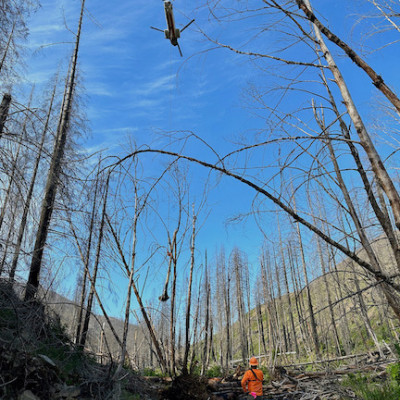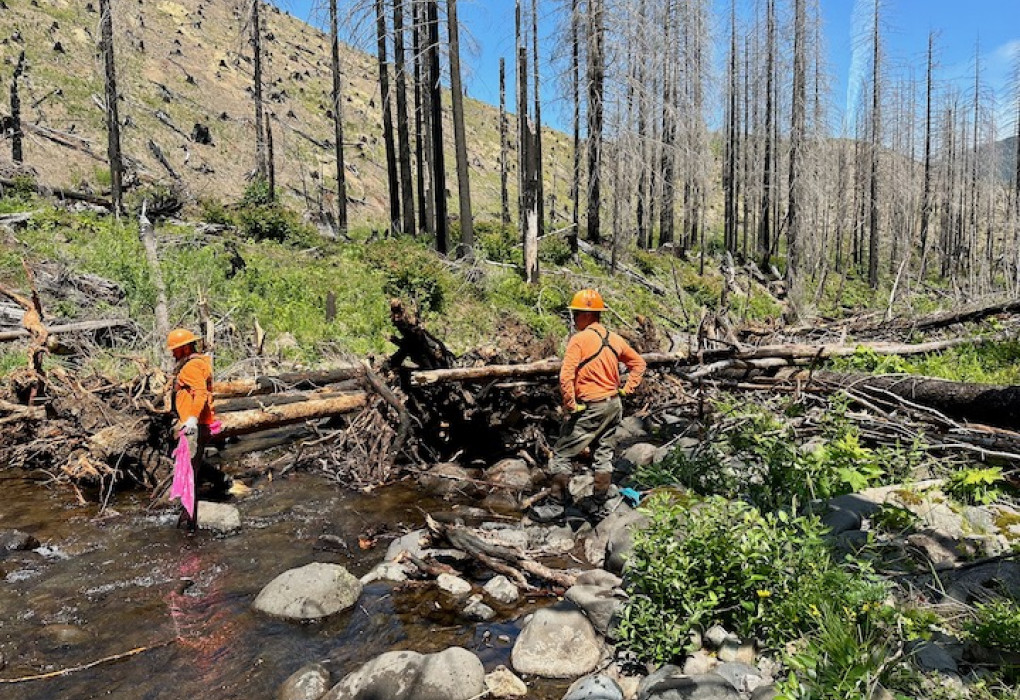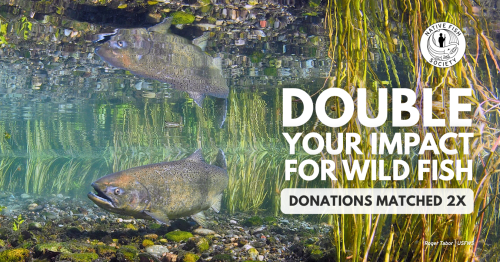Restoration Success!
Even the guys who had worked with Columbia Helicopters before couldn’t help but get a little excited as the Vertol helicopter came into view over the hills early on the morning of June 14. As the helicopter slowly lowered down to the staging area, it kicked up dust and gravel, forcing us to retreat behind pick-up trucks. Dave Stewart of ODFW and I quickly relayed our plan for placing the wood to Erik Stamatz of Columbia. The three ground crews, made up of both Columbia workers and ODFW fish biologists, quickly assembled and each crew moved into position along the 1.3 mile length of Copper Creek we were adding wood to.
The 500 pieces of wood, consisting of trees burnt in the 2020 fires and most with root wads still attached, were added to Copper Creek for two reasons. The first was to capture sediment that might come as a result of hillslope failure due to the Beachie Creek Fire, improving water quality both for aquatic animals as well as the drinking water for the cities of Molalla and Canby. Secondly, to create scour pools and reconnect side channels to provide additional rearing habitat for juvenile winter steelhead, an ESA-listed species in the Molalla watershed.
Adding to the efficiency of the operation was Jon Greenup, of Greenup Enterprises, a logging contractor based in Molalla. Jon quickly learned exactly how big of a load the Vertol could pick up and he used his loader to bundle one to four pieces of large wood. Erik, Dave, and I had all been concerned about the safety of the ground crews given the long-dead burned alders in the riparian zones. It seemed the trees could easily be downed by the rotor wash of the helicopter, putting the ground crews at risk. As a result, Columbia decided to use a grapple for the helicopter to pick up wood rather than a traditional choker that would require at least one member of the ground crew to run in and unhook the logs. It turned out that with all the storms the dead trees had been through since the fires, most had lost all their branches and were actually more stable to work under than green trees that catch so much rotor wash with leaves and branches. But the grapple had some unexpected benefits: it allowed the pilot to pick up and move a piece of wood if the ground crew wasn’t quite happy with its placement, and it also allowed the pilot to move some trees with root wads that were spanning the creek so that they were actually in the creek contributing to the habitat.
By the end of the first day, after 7 hours of flying, we had placed 275 pieces of wood over the course of 120 loads. We thought it might take us a full 3-4 days of work to place all 500 pieces, but it seemed we might be able to do it in much less time!
That first day, I had stayed up on the road, observing from above and providing some feedback via radio to the least experienced crew. Though it was quite exciting at first, I confess that the novelty did start to wear off as the afternoon wore on. At the end of the day, Dave suggested I join him down in the creek the next day and call in some log placements myself. I jumped at the chance and so made my way down to the creek early the next morning, uncertain about how quickly the turns between logs would be and how fast we’d have to move. It turns out that having three teams with the helicopter delivering a load to each before circling back around was a great strategy. We were efficient without having to stress about running to safety and back.
Determining the log placement was a fun experience too. Using our knowledge of natural PNW rivers, such as the Queets on the Olympic Peninsula, and hydrological processes, Dave and I would determine where we wanted the root wad and where we wanted the top of each piece. We would relay this to the Columbia ground crew, who would then throw a large pink flag tied around a rock to indicate to the pilot where the root wad should go and a large blue flag to indicate where the top should go. The pilot was so amazingly accurate and skilled that the ground crew lost a couple of their flags because the wood had been placed exactly on top of them.
That second day we finished up placing all the rest of the wood in less than 6 hours of flying! Again, the pilot was able to take existing burned trees on the terraces and add them to the stream, resulting in more than 500 total pieces of wood added by helicopter.
As efficient as the helicopter was at placing large trees, the Vertol was limited in the weight it could carry and of course couldn’t fly too close to the powerlines that cross Copper Creek. So on Friday morning, Dave and I worked with Jon Greenup and one of Greenup’s workers to add an additional 50 pieces of wood to upper Copper Creek using loaders. We were able to finish up that work in only about five hours and I even got to take a turn at the loader throwing in some small “filler” pieces of wood.
All in all, this was a great project that we hope will help provide lots of additional rearing habitat for steelhead, as well as numerous other river and riparian species. We’re now looking forward to and planning for Phase II of the project, which will consist of building engineered log jams in the mainstem Molalla in a bid to create more spawning habitat for spring Chinook. Stay tuned for more updates as that project is scheduled for Summer 2024!


